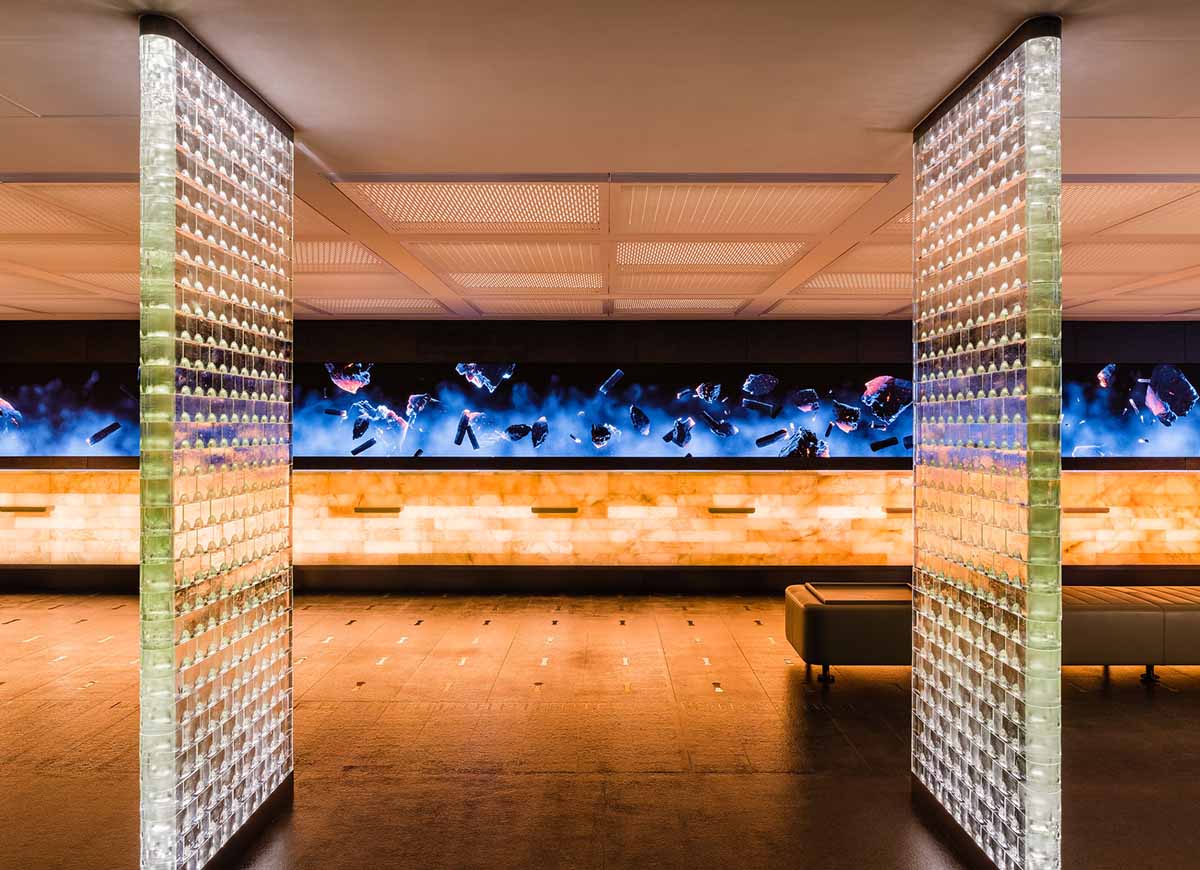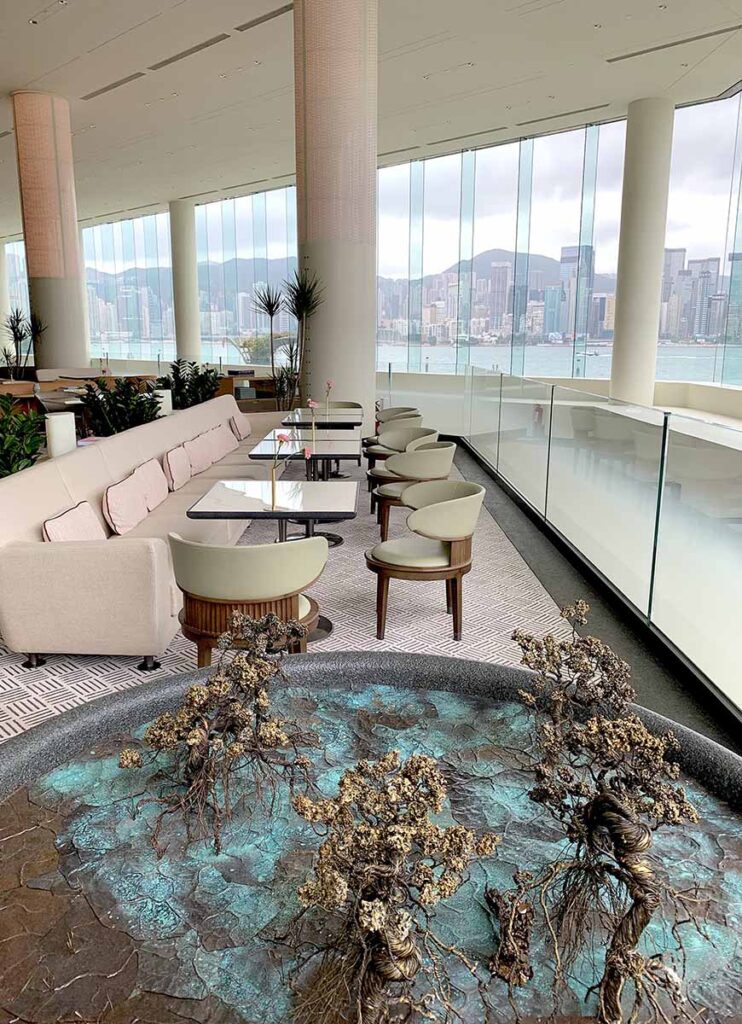
We visit the newly returned Regent Hong Kong on Victoria Harbour.

We visit the newly returned Regent Hong Kong on Victoria Harbour.
Driving up the ramped entrance leaving Salisbury Road behind, past a fountain and beneath a ceiling above the driveway featuring 18 recessed and hand-painted golden domes, the experience of arriving at Regent Hong Kong in Kowloon embodies that ultimate arrival moment when you know you’ve ventured somewhere special.
Regent Hong Kong is currently in a soft opening stage, with about 100 of its 497 rooms and suites currently open. The full reveal will take place later this year, in about the third quarter, when the entire range of rooms (including a three-bedroom presidential suite) will be open for bookings.
During a visit to celebrate the reopening of the Qantas International Hong Kong Lounge, I take a tour of the property with Jenny Chung, Director of Integrated Marketing and Communications.
The resurgence of the Regent Hotels & Resorts brand is part of parent company IHG’s strategic expansion to feature more luxury properties within the portfolio. The brand, established in the 1970s, now has eight hotels open around the world, including the Regent Phu Quoc, Regent Chongqing, Regent Shanghai, and Regent Porto Montenegro. A further 10 properties are due to open in the next five years including in Bali, Jakarta, Shanghai, and Kyoto.
Regent Hong Kong was opened in the 1980s but later morphed into an InterContinental Hotel. Now, fans of Regent can once more experience the brand when visiting Hong Kong — with nods to the past but an entirely refreshed design.
Design
Expect subtle design details and understated luxury touches at almost every turn. It starts before you even step out of your car, with the afore-mentioned drive and alighting from your vehicle.
Behind the project is the world-renowned architect and designer Chi Wing Lo, a Hong Kong national who has more than 30 years’ experience in projects that span the United States, Greece, and Italy. The interior design of the restaurants, Harbourside and The Steak House, has been expertly handled by Melbourne-based experts, Bar Studio.
Jenny explains that many elements of the original Regent have remained.
“We see ourselves as a mix of the past and present,” says Jenny.
“We want to remember our heritage. We were first opened in 1980 in the ‘golden age’ when Hong Kong was really taking off. It was interesting when we had our soft opening in March, many fans of the Regent brand all returned,” says Jenny.
“We respect the old, but we look forward to innovation and our interpretation to keep it new,” says Jenny.
“Little things that our previous guests will remember, such as trees that once stood in the Harbourside restaurant, we’ve retained planter trees throughout; and a lot of our former staff have re-joined us too.” The original marble staircase remains within the hotel, as does the open fire grill in The Steak House, first installed in the 1980s.
The seven-storey retail K11 Art Mall is located alongside the hotel, and there’s a direct access point for hotel guests. The city’s MTR (mass transit railway) stops there too, and the hotel is located close to key museums in the West Kowloon Cultural District.
“West Kowloon is the key development area in Hong Kong right now — that’s why we’re happy to come back at this particular time as it’s the place to be,” says Jenny.
At Harbourside restaurant, we view artwork on the wall titled Reflections on the Sea, which is a collection of circular discs that appear striking on their own — but Jenny explains that patterns etched in each disc are symbolic references to Hong Kong, including the lines of a classic junk boat.
At the hotel’s entrance, I learn that Chi Wing Lo’s design concept for the hotel was to create the effect of guests arriving at their own castle: the bold entry doors resemble bronze doors from ancient castles.
Inside, Chi Wing Lo, described as a “master of light” has played with his own interpretation of a hotel lobby chandelier. The building’s low ceilings don’t allow for such an object so instead, he “flipped the concept and created a horizontal chandelier” — with 16 glass panels made up of glass bricks that were laid, one by one, and the recurring theme of the entrance domes featured within the bricks.
In an old storage room, Chi Wing Lo found old artworks and hand-selected 18 which were strung together in a concertina-fan-style display.
Behind a long, glossy alabaster-like, and illuminated check-in counter (conveniently containing handbag or wallet resting ledges), a looping work is constantly on display by a Hong Kong digital artist.
“We want to have to create a concept here of the hotel being your personal haven. We don’t wish to over-stimulate guests and so everything is subtle,” says Jenny.
Large, designer books are dotted throughout the lobby. Hand-painted orchids adorn the space. An avocado-coloured stairwell that leads down to Harbourside restaurant carries a pattern made to resemble classic weaving – a motif repeated throughout the hotel in various spaces including in the lifts and in sliding, bathroom doors.

In the Lobby Lounge, guests have fabulous harbour views amid a soft palette of beiges and taupe with large semi-circular sofas, banquettes, and chairs that swivel to maximise the views. It’s here where a classic afternoon tea will be served.
Arriving at your room, guests have a little entranceway stepped in from the corridor. A luxury, says Jenny, that very few other hotels allow room for, but Chi Wing Lo insists that it’s all a key part of the ‘haven’ concept and leaving the other world of the corridor behind as you step into your own, castle-like domain.
Electronic blinds lift automatically on entry to a classic harbour view room, revealing vistas of Victoria Harbour.
“There are no artworks in our rooms, the view is the art in itself,” says Jenny.
To create another barrier from the outside world to the guest within, the designer created zen-like stone gardens on the window ledges outside each room. A long daybed runs the full length of the room and the ceiling has a scalloped detailing, designed to resemble the shape of a tent and to feel like you are almost camping.
“Most of the furniture is ‘floating’ and is built into the walls without the need for legs or bases, creating the illusion of more space in the room,” says Jenny.
Earthy soaking tubs by UK company Claybrook come with a timber ledge that contains a resting nook for phones, laptops, or iPads.
“Personally, I’d prefer to look out at the harbour,” says Jenny — and I couldn’t agree more.
Rates for a Classic Harbour View Room are typically around HKD $7500 (about AUD$1412 per night).
Latest Articles
Don't miss the latest from Luxury Travel
